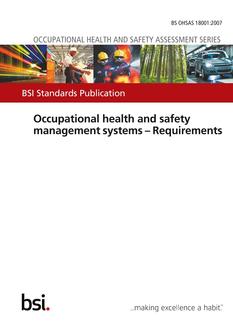
BS OHSAS 18001:2007
Click here to purchase
Foreword
This Occupational Health and Safety Assessment Series (OHSAS) Standard and the accompanying OHSAS 18002, Guidelines for the implementation of OHSAS 18001, have been developed in response to customer demand for a recognizable occupational health and safety management system standard against which their management systems can be assessed and certified.
OHSAS 18001 has been developed to be compatible with the ISO 9001:2000 (Quality) and ISO 14001:2004 (Environmental) management systems standards, in order to facilitate the integration of quality, environmental and occupational health and safety management systems by organizations, should they wish to do so.
This OHSAS Standard will be reviewed or amended when considered appropriate. Reviews will be conducted when new editions of either ISO 9001 or ISO 14001 are published, to ensure continuing compatibility.
This OHSAS Standard will be withdrawn on publication of its contents in, or as, an International Standard.
This OHSAS Standard has been drafted in accordance with the rules given in the ISO/IEC Directives, Part 2.
This second edition cancels and replaces the first edition (OHSAS 18001:1999), which has been technically revised.
The principal changes with respect to the previous edition are as follows.
– The importance of “health” has now been given greater emphasis.
– OHSAS 18001 now refers to itself as a standard, not a specification, or document, as in the earlier edition. This reflects the increasing adoption of OHSAS 18001 as the basis for national standards on occupational health and safety management systems.
– The “Plan-Do-Check-Act” model diagram is only given in the Introduction, in its entirety, and not also as sectional diagrams at the start of each major clause.
– Reference publications in Clause 2 have been limited to purely international documents.
– New definitions have been added, and existing definitions revised.
– Significant improvement in alignment with ISO 14001:2004 throughout the standard, and improved compatibility with ISO 9001:2000.
– The term “tolerable risk” has been replaced by the term “acceptable risk” (see 3.1).
– The term “accident” is now included in the term “incident” (see 3.9).
– The definition of the term “hazard” no longer refers to “damage to property or damage to the workplace environment” (see 3.6).
It is now considered that such “damage” is not directly related to occupational health and safety management, which is the purpose of this OHSAS Standard, and that it is included in the field of asset management. Instead, the risk of such “damage” having an effect on occupational health and safety should be identified through the organization’s risk assessment process, and be controlled through the application of appropriate risk controls.
– Sub-clauses 4.3.3 and 4.3.4 have been merged, in line with ISO 14001:2004.- A new requirement has been introduced for the consideration of the hierarchy of controls as part of OH&S planning (see 4.3.1).- Management of change is now more explicitly addressed (see 4.3.1 and 4.4.6).
– A new clause on the “Evaluation of compliance” (see 4.5.2) has been introduced.
– New requirements have been introduced for participation and consultation (see 4.4.3.2).
– New requirements have been introduced for the investigation of incidents (see 4.5.3.1).
This publication does not purport to include all necessary provisions of a contract. Users are responsible for its correct application.
Compliance with this Occupational Health and Safety Assessment Series (OHSAS) Standard cannot confer immunity from legal obligations.
Scope
This Occupational Health and Safety Assessment Series (OHSAS) Standard specifies requirements for an occupational health and safety (OH&S) management system, to enable an organization to control its OH&S risks and improve its OH&S performance. It does not state specific OH&S performance criteria, nor does it give detailed specifications for the design of a management system.
This OHSAS Standard is applicable to any organization that wishes to:
a) establish an OH&S management system to eliminate or minimize risks to personnel and other interested parties who could be exposed to OH&S hazards associated with its activities;b) implement, maintain and continually improve an OH&S management system;c) assure itself of its conformity with its stated OH&S policy;d) demonstrate conformity with this OHSAS Standard by:1) making a self-determination and self-declaration, or2) seeking confirmation of its conformance by parties having an interest in the organization, such as customers, or3) seeking confirmation of its self-declaration by a party external to the organization, or4) seeking certification/registration of its OH&S management system by an external organization.
All the requirements in this OHSAS Standard are intended to be incorporated into any OH&S management system. The extent of the application will depend on such factors as the OH&S policy of the organization, the nature of its activities and the risks and complexity of its operations.
This OHSAS Standard is intended to address occupational health and safety, and is not intended to address other health and safety areas such as employee wellbeing/wellness programmes, product safety, property damage or environmental impacts.
Reference publications
Other publications that provide information or guidance are listed in the bibliography. It is advisable that the latest editions of such publications be consulted. Specifically, reference should be made to:
OHSAS 18002, Occupational health and safety management systems. Guidelines for the implementation of OHSAS 18001
International Labour Organization:2001, Guidelines on OccupationalHealth and Safety Management Systems (OSH-MS)
Product Details
- Published:
- 07/31/2007
- ISBN(s):
- 9780580594045
- Number of Pages:
- 32
- File Size:
- 1 file , 1000 KB
- Product Code(s):
- 30148086, 30148086
- Note:
- This product is unavailable in United Kingdom

